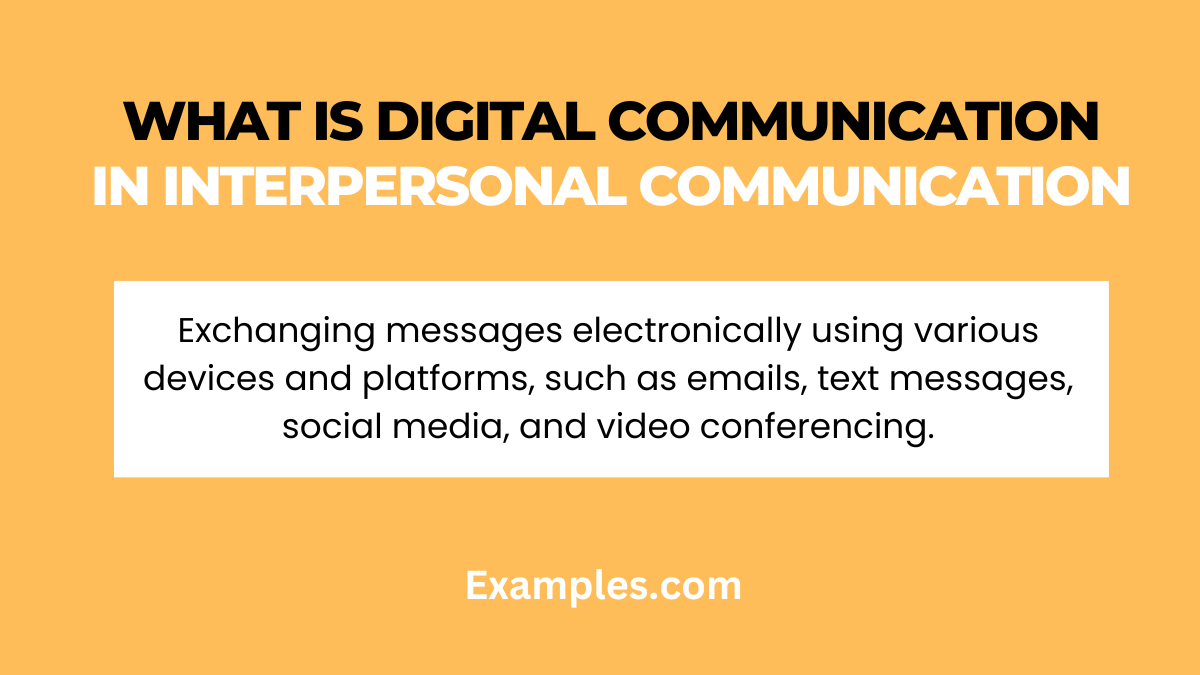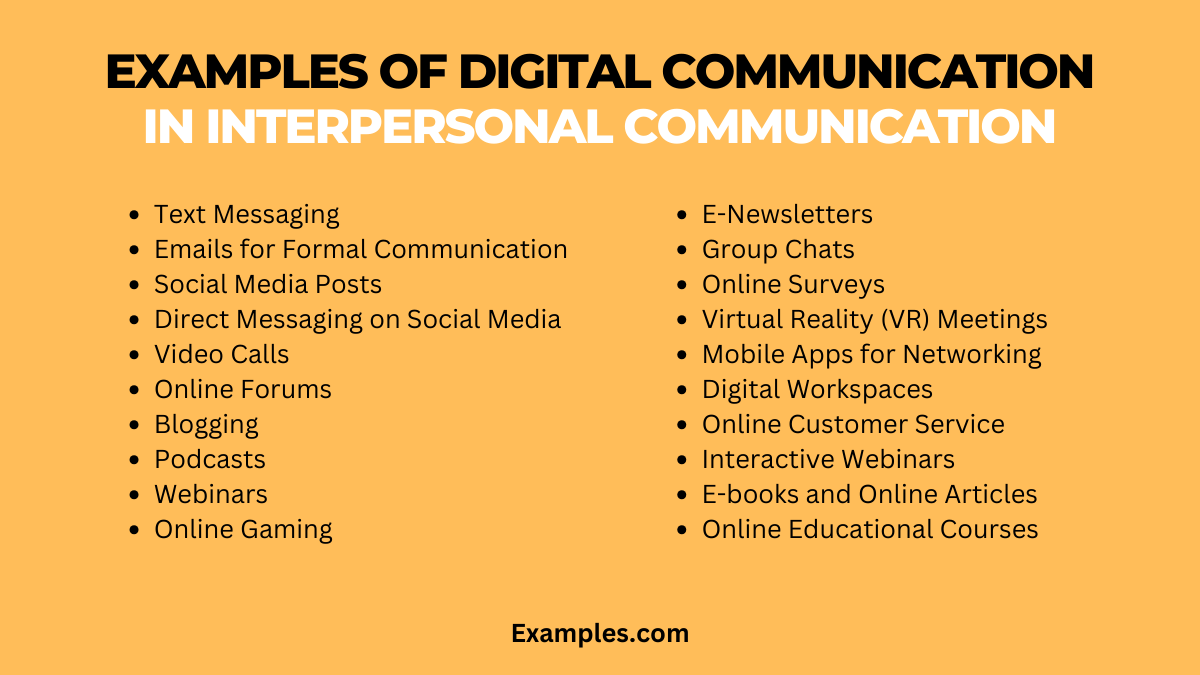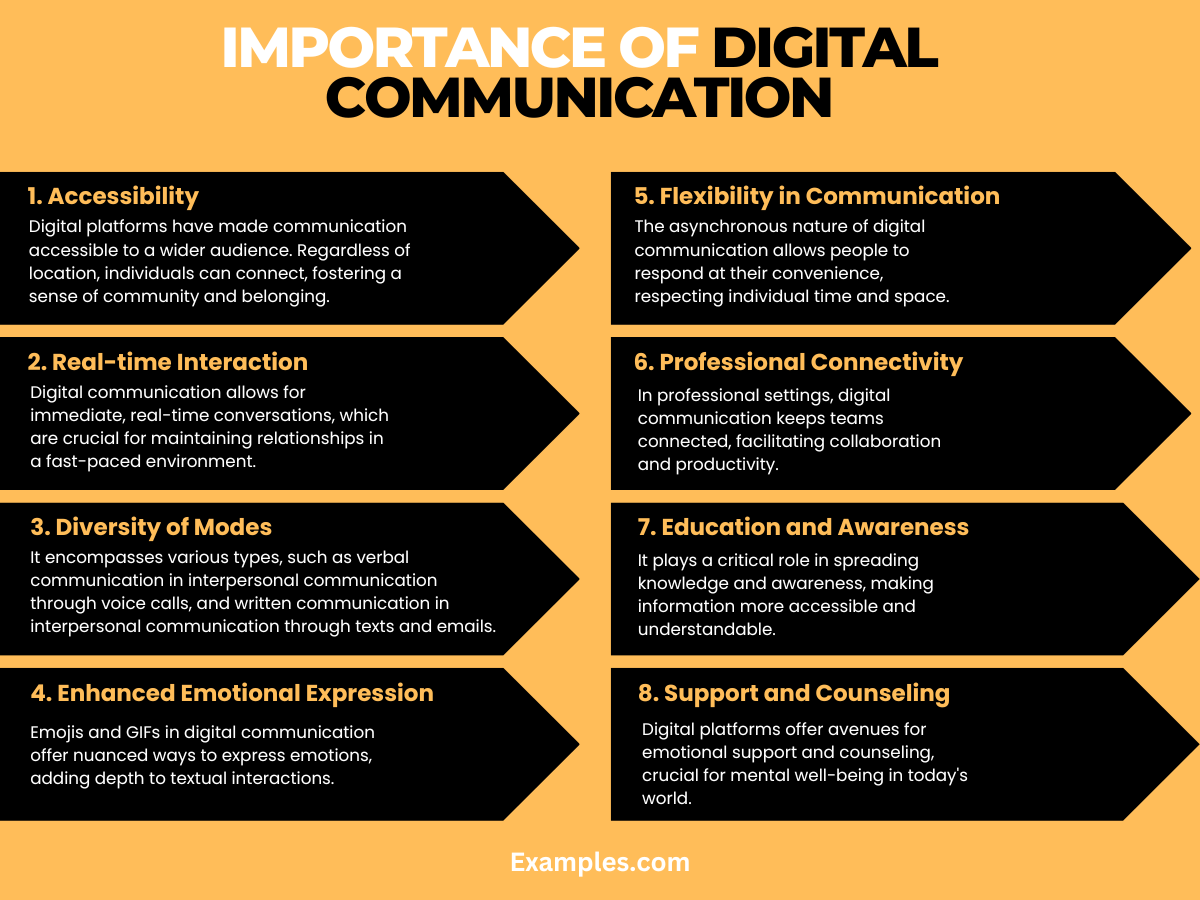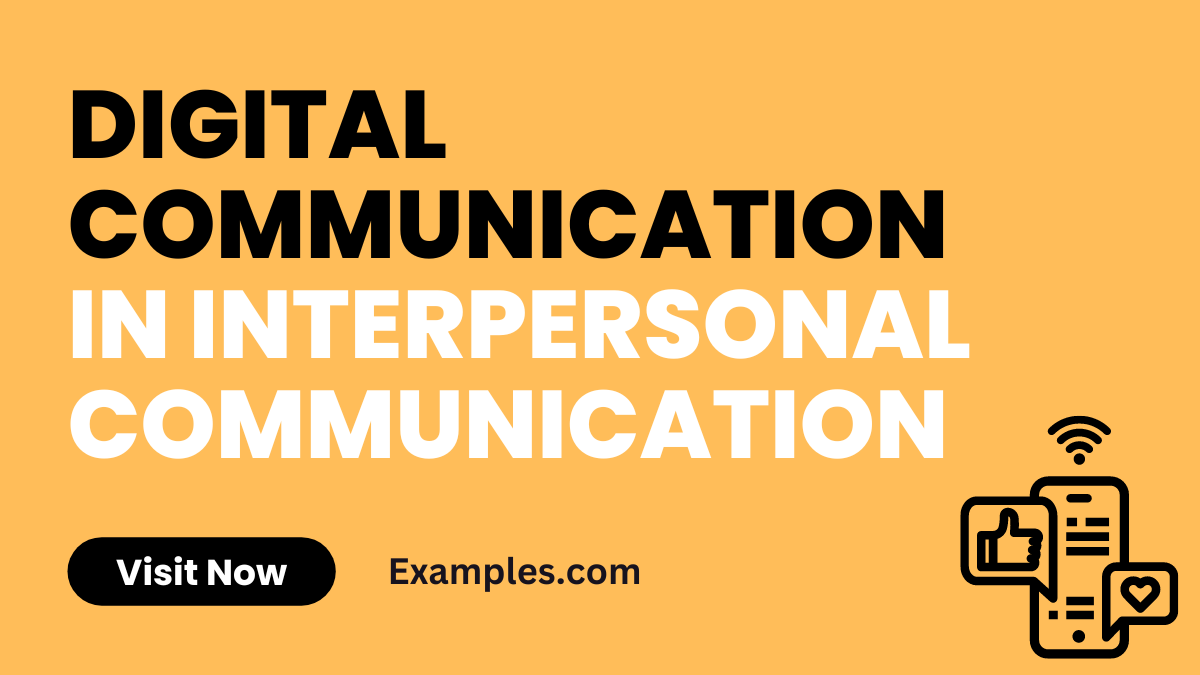19+ Digital Communication in Interpersonal Communication Examples
In an era where digital platforms shape our interactions, understanding Digital Communication in Interpersonal Communication is crucial. This guide delves into the dynamic interplay between technology and human connection, offering real-life examples and practical tips. We explore how digital tools can enhance or hinder interpersonal relationships, emphasizing the importance of adapting to this evolving communication landscape.
What is Digital Communication in Interpersonal Communication?

Digital Communication in Interpersonal Communication refers to the use of digital platforms and tools in facilitating interactions between individuals. This encompasses various forms, from social media messages to emails, offering diverse ways to connect, share information, and express emotions. Understanding its role and impact is essential in today’s digitally connected world.
What is the Best Example of Digital Communication in Interpersonal Communication?
A prime example of Digital Communication in Interpersonal Communication is the use of video conferencing tools, like Zoom or Skype. These platforms allow for real-time visual and verbal interaction, bridging geographical distances. They serve as a testament to how digital technology can replicate face-to-face interactions, fostering both personal and professional relationships in a digital age.
20 Examples of Digital Communication in Interpersonal Communication

Digital communication plays a pivotal role in modern interpersonal communication, blending technology with human interaction. It encompasses a range of methods, from texting and emailing to social media engagement, offering diverse platforms for expressing thoughts, emotions, and information. Embracing digital channels enhances connectivity and convenience, making communication more dynamic and inclusive.
- Text Messaging: Quick and concise, text messaging is ideal for sharing information or checking in.
Example: “Can we meet at 3 PM for coffee?” - Emails for Formal Communication: Emails are great for detailed and formal exchanges.
Example: “I’ve attached the report for your review. Please let me know your thoughts.” - Social Media Posts: Sharing updates or opinions on platforms like Facebook or Twitter.
Example: “Excited about the new project! #NewBeginnings” - Direct Messaging on Social Media: For private conversations on platforms like Instagram.
Example: “Loved your recent post! Let’s catch up soon.” - Video Calls: Personal and engaging, ideal for face-to-face interaction.
Example: “Let’s have a Zoom call to discuss the details.” - Online Forums: Engaging in topic-specific discussions.
Example: “I agree with your point on the forum, let’s explore this idea further.” - Blogging: Sharing detailed thoughts or stories online.
Example: “Check out my latest blog post on effective communication strategies.” - Podcasts: Listening to or hosting discussions on various topics.
Example: “I discussed digital communication trends in my latest podcast episode.” - Webinars: Participating in online seminars for learning or discussion.
Example: “Joining a webinar on digital marketing strategies tomorrow.” - Online Gaming: Communicating through in-game chats or voice messages.
Example: “Great game! Let’s team up again soon.” - E-Newsletters: Receiving or sending informational emails.
Example: “Our monthly newsletter has tips on effective digital communication.” - Group Chats: Multi-person conversations for planning or discussion.
Example: “Let’s finalize the meeting agenda in our group chat.” - Online Surveys: Collecting feedback or opinions digitally.
Example: “Please fill out this survey to help improve our communication tools.” - Virtual Reality (VR) Meetings: Immersive meetings using VR technology.
Example: “Joining the VR meeting room at 4 PM for the project discussion.” - Mobile Apps for Networking: Using apps like LinkedIn for professional networking.
Example: “Connected with industry experts through the app.” - Digital Workspaces: Collaborating on projects via platforms like Slack.
Example: “Please check the Slack channel for the latest updates.” - Online Customer Service: Using chatbots or support systems for assistance.
Example: “Our customer service chatbot can help with your query.” - Interactive Webinars: Participating in webinars with Q&A sessions.
Example: “The interactive webinar on communication skills was insightful.” - E-books and Online Articles: Reading or writing digital literature for knowledge sharing.
Example: “I’ve published an e-book on digital communication etiquette.” - Online Educational Courses: Learning new skills through digital platforms.
Example: “Enrolled in an online course on effective digital communication strategies.”
Importance of Digital Communication in Interpersonal Communication

In the contemporary world, digital communication has become an integral part of interpersonal interactions. It bridges geographical distances and enables constant connectivity, proving to be a cornerstone of modern communication strategies. This section delves into how digital communication, as part of the broader Interpersonal Communication landscape, enriches and transforms human interactions.
- Accessibility: Digital platforms have made communication accessible to a wider audience. Regardless of location, individuals can connect, fostering a sense of community and belonging.
- Real-time Interaction: Digital communication allows for immediate, real-time conversations, which are crucial for maintaining relationships in a fast-paced environment.
- Diversity of Modes: It encompasses various types, such as verbal communication in interpersonal communication through voice calls, and written communication in interpersonal communication through texts and emails.
- Enhanced Emotional Expression: Emojis and GIFs in digital communication offer nuanced ways to express emotions, adding depth to textual interactions.
- Flexibility in Communication: The asynchronous nature of digital communication allows people to respond at their convenience, respecting individual time and space.
- Professional Connectivity: In professional settings, digital communication keeps teams connected, facilitating collaboration and productivity.
- Education and Awareness: It plays a critical role in spreading knowledge and awareness, making information more accessible and understandable.
- Support and Counseling: Digital platforms offer avenues for emotional support and counseling, crucial for mental well-being in today’s world.
Negative Effects of Digital Communication in Interpersonal Communication
Despite its benefits, digital communication can also have adverse effects on interpersonal relationships. This section outlines the potential pitfalls and challenges it poses.
- Misinterpretation: Without non-verbal cues, messages can be easily misunderstood, leading to conflicts or miscommunications.
- Over-reliance on Digital Mediums: Excessive dependence on digital communication can lead to a decline in face-to-face interactions and weaken physical relationship bonds.
- Privacy Concerns: Digital communication raises issues regarding privacy and data security, creating distrust among users.
- Digital Divide: Not everyone has equal access to digital platforms, leading to a communication gap between different societal groups.
- Impact on Mental Health: Constant digital connectivity can lead to anxiety and stress, impacting mental health.
- Reduced Attention Span: The fast-paced nature of digital communication can diminish concentration and patience for longer, more thoughtful conversations.
- Erosion of Social Skills: Overuse of digital communication might result in diminished real-life social skills, especially in younger generations.
- Cyberbullying and Harassment: Digital platforms can be misused for cyberbullying or harassment, negatively impacting individuals’ mental health and well-being.
While digital communication is a vital component of Interpersonal Communication, balancing its use with traditional forms of interaction is essential to maintain healthy, meaningful relationships.
In conclusion, digital communication has become an indispensable part of interpersonal interaction, significantly influencing how we connect, share, and engage with others. As we navigate this digital landscape, it is crucial to balance its use with traditional communication methods to maintain healthy, meaningful relationships. Embracing digital communication while being aware of its challenges ensures that we leverage technology to enhance, not hinder, our interpersonal connections.
For further insight into the impact of digital communication, consider exploring resources from reputable educational institutions likeHarvard University’s Digital Communication Program which offers comprehensive learning on digital communication strategies.



